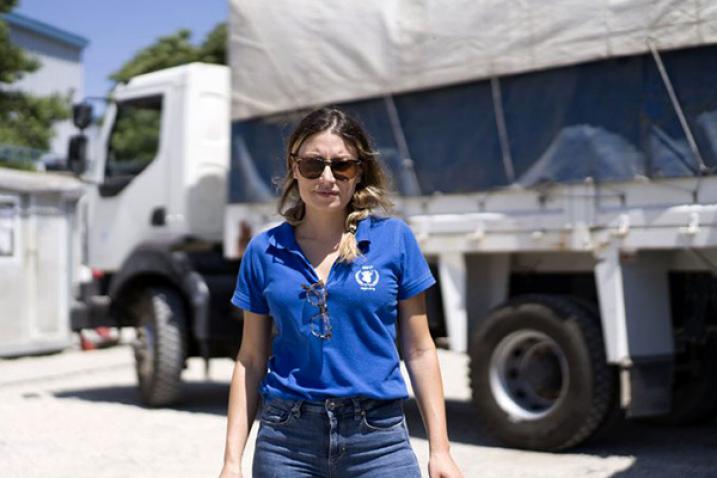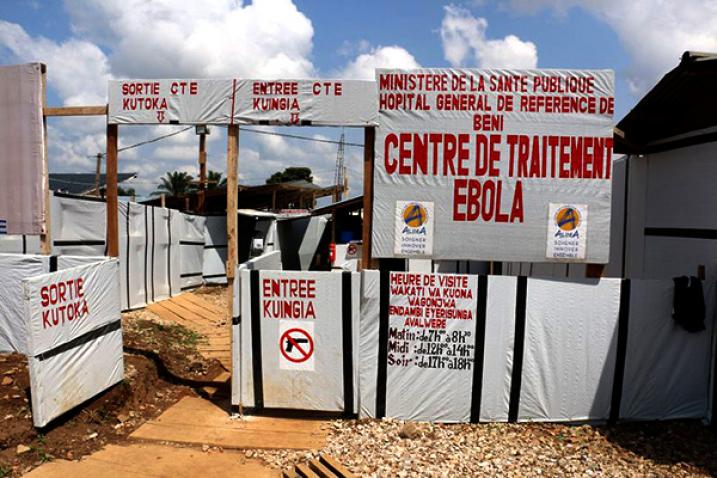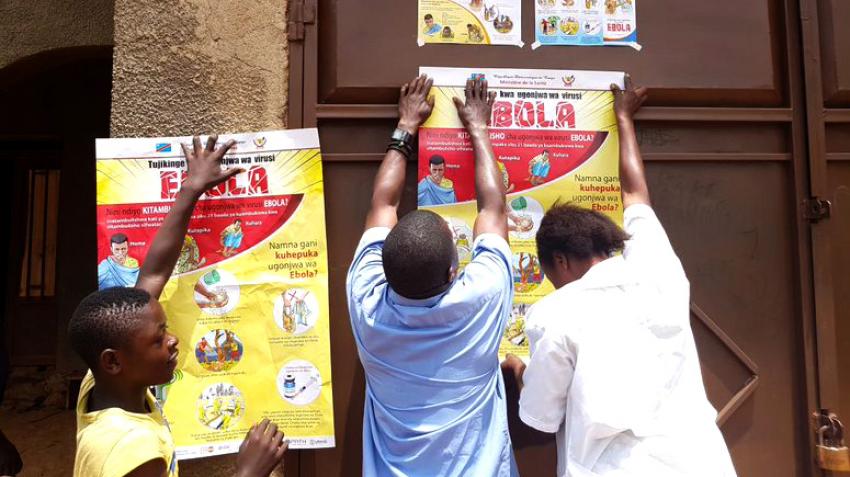“The decisive factor in the victory over smallpox was global solidarity.” – WHO Director-General
13 May 2020 — Since arriving in Haiti four months ago, Chiara Camassa, an administration officer for the World Food Programme (WFP), has been the agency’s ‘focal point’ for COVID-19 issues — largely due to her experience with the Ebola outbreak in West Africa in 2014.
“The effectiveness of our response ultimately depends on our staff,” she said. “One big difference is that Ebola was a regional crisis and COVID-19 is a global outbreak.”
According to the World Health Organization (WHO), 11,310 people died after contracting the Ebola virus between 2014 and 2016. As of 13 May, COVID-19 killed 287,399 people, and positive cases have topped 4 million globally.
During the Ebola outbreak, Ms. Camassa added, it was not difficult to deploy staff. More than 150 people arrived in the first two months to help with the response.
In the case of COVID-19, movement restrictions mean that the agency mostly has to work with available resources and in-country personnel. “That’s a very new challenge for us,” she said, emphasizing that it is essential to train staff on preventive actions, protect them and the communities they come in contact with, and to pay attention to their wellbeing, as they can spend a very long time without relatives in a country that is not their own.
During the Ebola crisis, she worked from WFP’s regional response hub of Accra, Ghana, responsible for the deployment and tracking of assets, mostly generators, prefabs, sanitation structures and other equipment for treatment centres, offices and infrastructure throughout three affected countries: Guinea, Liberia and Sierra Leone.
She explained that WFP, as the organization delivering food assistance, also plays an important role in procuring and moving such assets and participating in the construction of treatment centres.
She frequently travelled between the three countries, sometimes to remote villages by helicopter, to keep track of assets and understand how they were being deployed and used. Going into these remote villages, which were often inaccessible by road or where trucks would get stuck in the mud, it was rewarding to see that food aid was reaching families in need.
The assistance meant that people would not have to take long journeys to buy food to put on the table. It allowed them to stay at home and avoid contact with others, which helped to prevent the spread of the virus.
“In both contexts, food assistance can help facilitate sheltering at home,” she said.
In Haiti, WFP was able to deliver a month’s worth of food rations to the people in Ennery in the town of Artibonite, just before the town was placed under quarantine by the Government.

Inter-agency coordination and colloboration
Natasha Nadazdin, WFP Senior Programmer Adviser for the West Africa region, said that the death toll during the Ebola crisis would have been much higher were it not for WFP venturing out of its traditional areas of expertise.
“The initial thinking was this is a medical crisis and we cannot cross lines and we shouldn’t be doing things WHO should be doing,” says Natasha. “But when we became aware of the potential dimensions of that crisis, then it became clear that WFP would have to get involved in a very serious way because of our logistics capacity to procure quickly and organise the supply chain.”
A “new dialogue” was created as WHO and other medical organizations asked WFP to get involved in the future planning of coverage with essential medical supplies in Africa, she said.
In an editorial, titled “Learning from Ebola: readiness for outbreaks and emergencies,” Margaret Chan, who was leading WHO then, wrote: “The Ebola outbreak has taught us many lessons, among them that the response to outbreaks and emergencies must start and end at ground level – which means that certain key capacities have to be in place before launching a response, including leadership and coordination, technical support, logistics, management of human resources and communications.”
“It has also shown that the organizations working to contain outbreaks and emergencies must collaborate closely,” she added.
In February, WHO appointed six special envoys on COVID-19, to provide strategic advice and high-level political advocacy and engagement in different parts of the world, including David Nabarro, who was Special Envoy of the United Nations Secretary-General on Ebola.
Chase Sova, WFP USA senior director of public policy and research, noted that during the Severe Acute Respiratory Syndrome (SARS) and Middle East Respiratory Syndrome (MERS) outbreaks in China there was minimal disruption to markets and prices locally, owing to sufficient buffer stocks and measures taken to ensure the continued flow of goods.
However, during the 2014 Ebola outbreak in West Africa, prices of staple foods rose dramatically in affected countries, he said, noting that COVID-19 will likely affect food security.

The United Nations Children’s Fund (UNICEF), in a report, titled “Mitigating the effects of the COVID-19 pandemic on food and nutrition of schoolchildren”, said that lessons learnt from other epidemics such as Ebola, point to the efficacy of reallocating food from the school feeding programme to the overall emergency response in order to assist entire vulnerable households, or using school canteens to reach extremely vulnerable groups, such as children in Ebola-affected households and Ebola-orphans living with host families.
Instead of directly targeting Ebola-affected households, all children attending the selected schools were given assistance, helping communities overcome stigmatization and rebuild trust in agencies and authorities, UNICEF says.
West African nations apply past lessons
West African countries are now applying insights gained from addressing the 2014-2016 Ebola outbreak to tackle COVID-19 with notable success.
Sierra Leone was one of the countries hardest hit by Ebola, with more than 14,000 cases and nearly 4,000 deaths. The pandemic overwhelmed the country’s fragile public health system, which was still rebuilding after a brutal civil war, and struggling to meet demands for additional healthcare practitioners.
At the time of writing, there were 338 confirmed cases and 19 deaths related to COVID-19 in the country.
The International Organization for Migration (IOM) says that these numbers are relatively low, in part because of what Sierra Leone learned from the Ebola outbreak.
The country developed a COVID-19 preparedness plan three weeks before its first case was confirmed. This enabled the Ministry of Health to quickly identify, test and quarantine most of the primary contacts of the index case, thereby limiting spread of the disease.
In a region known for its porous land borders and high degree of cross-border trade, disease surveillance and health screening are key to detection and referring potentially ill travelers to adequate healthcare structures to limit the spread of any disease. Engaging with communities in high-risk border areas, crowded urban slums and informal settlements also plays a significant role in further preventing the spread of a disease.
“During the Ebola, IOM conducted a nationwide programme on Infection Prevention and Control training for frontline workers, officials at border points, established water, sanitation and hygiene (WASH) surveillance systems at key points of entry (POE) and community engagement on hygiene practices to break the chain of transmission,” says James Bagonza, who leads IOM operations in Sierra Leone.

In 2016, after Sierra Leone became Ebola-free, the country counted 156 doctors and 5,668 nurses for a population of just over 7 million people, according to WHO. Although human resources remain limited, the Government has made substantial improvements to its public health system, especially in response to COVID-19. As of 9 April, there were 130 hospital beds available for COVID-19 patients, plus 200 oxygen concentrators and 15 beds for patients needing intensive care.
In neighbouring Liberia, the country hardest hit by Ebola, with 4,809 deaths, an official with the Office of the United Nations High Commissioner for Refugees (UNHCR), is drawing on her experience during that outbreak to develop public messaging on COVID-19.
Having fled the civil war in Liberia as a child in 1991, Miata Tubee Johnson, a former refugee and now a public health officer with UNHCR, worked to make sure refugees were well informed about how to prevent Ebola transmission . She also partnered with a team to convince governments to include refugees in the national Ebola prevention plan.
“My experience in Liberia actually prepared me for where I am today,” she says. “I feel a sense of déjà vu.”
While COVID-19 has a different transmission and etiology to Ebola, Miata draws broadly on that experience to provide lifesaving public health messaging and call for the integration of refugees into the national coronavirus response.
Learning from SARS
The Asia-Pacific region is also learning from past pandemics.
In a January 2020 report, titled “For the Future Towards the Healthiest and Safest Region” and published before the COVID-19 outbreak, WHO’s Western Pacific Regional Office said that the region has made considerable progress in strengthening health security systems over the last decade, building on lessons from the SARS epidemic, the H1N1 influenza pandemic and other real-life events – leading to the development and implementation of the Asia Pacific Strategy for Emerging Diseases and Public Health Emergencies.
In 2003, Viet Nam became the first country to be removed from the list of countries with local transmission of SARS, the first major novel infectious disease to hit South-East Asia and the international community.

At the time of writing, Viet Nam reported no COVID-19 deaths. "There are many lessons from Viet Nam’s COVID-19 response which should be shared with the rest of the world on how to contain pandemics and infectious diseases based on both its previous SARS and now COVID-19 experiences," said Kamal Malhotra, UN Resident Coordinator in the country, in a recent opinion piece.
Global solidarity defeats smallpox
On 8 May, WHO celebrated the fortieth anniversary of the eradication of smallpox by unveiling a commemorative postal stamp developed by the United Nations Postal Administration (UNPA).
“As the world confronts the COVID-19 pandemic, humanity’s victory over smallpox is a reminder of what is possible when nations come together to fight a common health threat,” said WHO Director-General Tedros Adhanom Ghebreyesus in his briefing that day.
The eradication of smallpox – through international cooperation - remains one of the biggest accomplishments in global public health.
— António Guterres (@antonioguterres) May 9, 2020
40 years on - as the fight against #COVID19 continues - it is a timely reminder of the power of science-based solidarity. pic.twitter.com/RQDp2AfD8B
Many of the basic public health tools that were used successfully then are the same tools that have been used to respond to Ebola, and to COVID-19: disease surveillance, case finding, contact tracing, and mass communication campaigns to inform affected populations.
“The smallpox eradication campaign had one crucial tool that we don’t have for COVID-19 yet: a vaccine; in fact, the world’s first vaccine,” he said, emphasizing the need to accelerate the development of a vaccine for COVID-19.
But although a vaccine was crucial for ending smallpox, it was not enough on its own, he added. After all, the vaccine was first developed by Edward Jenner in 1796. It took another 184 years for smallpox to be eradicated.
“The decisive factor in the victory over smallpox was global solidarity,” Mr. Tedros stressed, noting that at the height of the Cold War, the Soviet Union and the United States joined forces to conquer a common enemy.
“That same solidarity, built on national unity, is needed now more than ever to defeat COVID-19,” he said.




